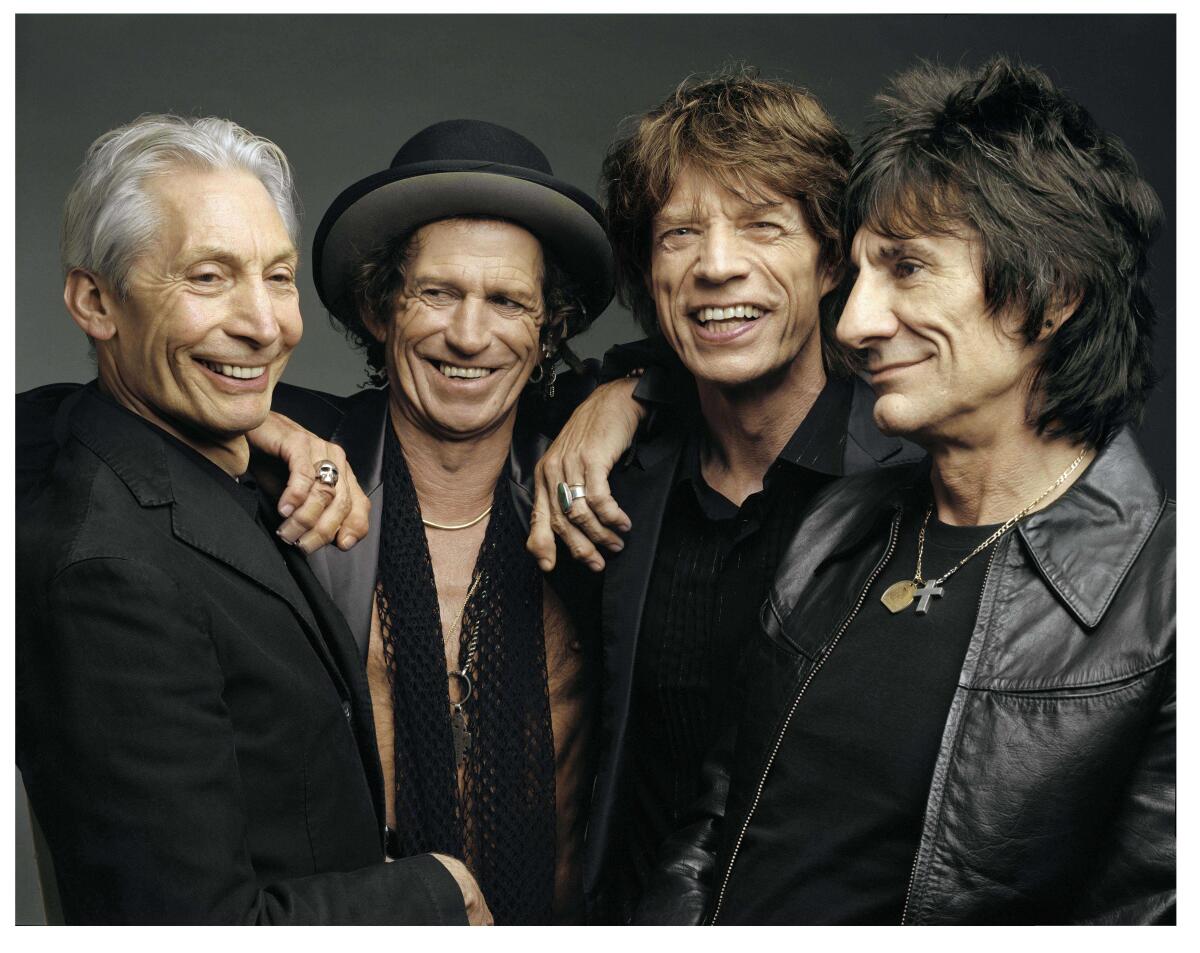A new doc shines a light on the Rolling Stones as individuals, not just a band

- Share via
Whether or not you accept the Rolling Stones as “the world’s greatest rock ’n’ roll band” — and at this stage of the game there isn’t any other group of stature even playing that music — they are certainly the world’s most documented. The Beatles, of course, left a considerable film and photographic record, but they broke up in 1970, whereas the septuagenarian Stones have just finished their latest tour, celebrating 60 years in show business. And they have been the subjects (and often producers) of documentary films and series all along the way.
For a time, rock musicians were comfortable with letting cameras follow them around, even if they were not always happy with the results; there was an assumption that this process might produce something interesting. The early history of the Stones on film is also a history of the era’s filmmaking, including “Charlie Is My Darling,” shot in black-and-white on a 1965 tour of Ireland (though not officially released until decades later); Jean-Luc Godard’s “One on One,” portions of which catch the band in the studio taking “Sympathy for the Devil” from an acoustic ballad to Latinesque rager; the brilliant “Gimme Shelter,” Albert and David Maysles and Charlotte Zwerin’s nail in the coffin of the 1960s; and Robert Frank and Daniel Seymour’s never-released, uncomfortably revealing, cut-up cinema vérité film of the band’s 1972 American tour, whose title may not be written here. (You can find it on YouTube, surprisingly.) These films are not merely about the band but about their audience and what the audience projected, sometimes unhealthily, upon them.
After that, what you find are a plethora of concert souvenirs, including Martin Scorsese’s 2008 “Shine a Light,” and a combination of unauthorized pieces that rely on old footage and outside commentators (featuring not always favorable critical assessments of the band’s creative history) and more managed, self-celebrating official productions. That isn’t to say the latter are totally whitewashed. The members’ various drug addictions are too well known to completely gloss over, and Mick Jagger’s and Keith Richards’ periods of disaffection were news in their time. Nor is the band uncomfortable discussing them; the old bad-boy image allows for a certain amount of transgressive behavior to be proudly owned. (There are things, of course, that will never be known.) At the same time, the Stones have become safe, and safely established as the world’s premier party band; they have buried their hatchets, cleaned up their acts and become in their own way the “lovable scamps” the Beatles were once sold as. The story now is one of survival and triumph and old mates in love. It is rather touching.
Given how many times their story has been told, does it need another retelling? Is there more to learn? Might as well say they should never tour again, that they should have died before they got old. (That’s another band, I know.) Even were I not reviewing it, I’m sure I would have watched the new “My Life as a Rolling Stone,” an Epix/BBC co-production premiering here Sunday, and I have seen enough of these things to teach a course on the band. And in fact, the series’ novel structure does make room for some fresh material, according one hour each to what, until the death last year of drummer Charlie Watts, were the last Stones standing: Jagger, Richards, Ron Wood and Watts. (The Watts episode relies on archival interviews with the drummer, but the other members all sit for new conversations.) There is a little less emphasis on retelling the history and a little more on discussing the art, though they are all engagingly self-deprecating on that account. (Asked if he has a good voice, Jagger answers, “No … it’s OK. It does its job.”)
Mick and Keith (we’ll use first names here, as the world does), who first knew each other in elementary school and famously met again on a train platform in their late teens, are well-traveled territory. The love and hate, the yin and yang, the rifts and reconciliations between them take center stage in most recountings, which makes the episodes focusing on second guitarist Ronnie (the “new kid,” in the band for nearly half a century) and Charlie, the drummer, the more immediately interesting episodes. Significantly, former Rolling Stones get scant mention. Brian Jones, who founded the band, cuts a rather pathetic figure; Mick Taylor, who replaced him, is brought up largely because his departure left the hole that Wood filled; and original bassist Bill Wyman, who quit the band in 1993, is named only once, though of course he appears in lots of old photos and footage.

A mosaic that hops around in time, “My Life as a Rolling Stone” leaves out much — which you can, after all, find covered elsewhere. The historical highlights are here — drug bust at Keith’s house, Hyde Park ’69, Altamont, tax exile, New York flatbed truck performance, swerve into disco — but as onstage, examination of the band’s catalog pretty much ends in the mid-’70s. Though they continued to make, at wide intervals, new albums — the last of original material, “A Bigger Bang,” dates from 2005 — what follows are the Years of Spectacle: the Stones as stadium-filling traveling museum, a guaranteed good time with a multigenerational audience, a considerable portion of which has to rely on documentaries like this to get a sense of the group’s erstwhile cultural currency, the sense of threat they generated and the chaos that followed them. These days, as it’s been for a long time, things are more organized. As Ronnie, formerly of the shambolic Faces, observes of touring with the Stones, “We would get newsletters, we’d know what we were doing, when we were going to be doing it.”
Each episode has a thematic spin. Mick is the commander, the organizer, the engine driver, the ringmaster. (“I’m not a control freak,” he protests. “That must be really boring.”) His episode is the most chronological, tracing the course of the Stones from band to brand. From the band’s earliest days, he understood the importance of television: “I would work out how the camera angles worked, I would work out what we were going to do. And I would practice my moves at home, and I would be rehearsed.” (There is even older TV footage, presented without context, of a schoolboy Mick climbing a cliff.) Keith’s episode concentrates on the music, its roots and transformations. We see his first guitar and learn that his constant playing of Beatles songs to understand pop writing drove Mick “batty”; hear of the “mystical” properties of his five-string open G tuning (“a cheap ride to heaven”); and discover that, in Mick’s words, he is “terribly shy.” Ronnie, who felt destined to become a Rolling Stone even before it was a possibility, is pictured as the mischief maker (“He’s carefree, a proper old bohemian he is,” says his old Faces bandmate Rod Stewart), but also the mediator, whose hiring helped reinvigorate the band in the mid-’70s, after which, says Mick, their presentation became “more of a fun thing, not so dangerous.”
The complete guide to home viewing
Get Screen Gab for everything about the TV shows and streaming movies everyone’s talking about.
You may occasionally receive promotional content from the Los Angeles Times.
As for Charlie, he was my favorite Rolling Stone, not merely for his playing but for his composure, his admirably long marriage and, ironically, his oft-stated ambivalence about the whole thing. (“I think the Rolling Stones are great, but I kind of don’t see me in it somehow. ... When the music stopped, I wish I could have turned it off. I hated it. I hated being chased by girls and all that. It used to really embarrass me.”) His episode has the least to do with the band, or the most to do with his life outside it. His jazz roots — we get to hear his first recording in such a context — provide a musical, sartorial and philosophical throughline. There is a segment on his big-band project and a visit to the “secret location” where Watts’ collection of historical drum kits — once belonging to Gene Krupa, Art Blakey, Tony Williams, D.J. Fontana and others — is stored, along with his own traveling tea set. We get a look at the line drawings he would do in his hotel room while not partying with the rest of the group; we visit his tailor; we see his dogs and horses.
That episode begins in St. Louis last year at the first show the band played without Charlie. Paying tribute to him from the stage, Mick is clearly emotional; Keith holds his hands. “Time is on my side,” he sang once long ago, and also “Baby, you’re out of time.” Now they are three, but meanwhile the Stones roll on.
More to Read
The complete guide to home viewing
Get Screen Gab for everything about the TV shows and streaming movies everyone’s talking about.
You may occasionally receive promotional content from the Los Angeles Times.







